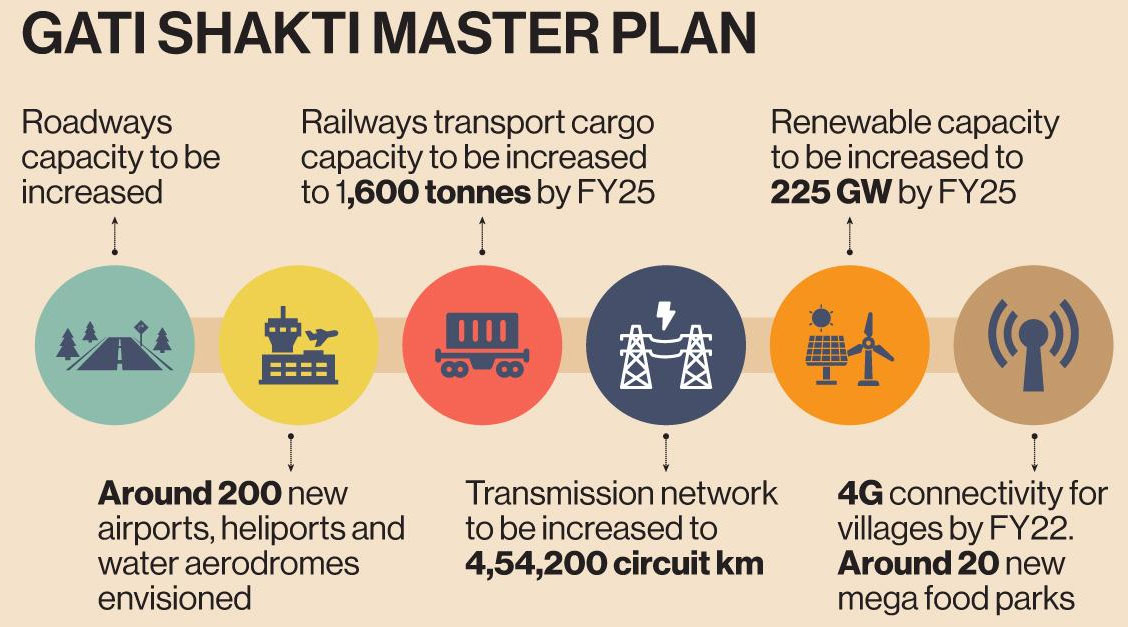First Gati Shakti Cargo Terminal | 15 Mar 2022
For Prelims: PM Gati Shakti Scheme, National Infrastructure Pipeline.
For Mains: Mobilisation of Resources, Government Budgeting, Fiscal Policy, Government Policies & Interventions, Significance of PM Gati Shakti Scheme.
Why in News?
Indian Railways’ first Gati Shakti Cargo Terminal commissioned in Asansol Division in pursuance of the Prime Minister’s vision “Gati Shakti”.
- This is the first such GCT commissioned in Indian Railways since the publication of GCT policy in December 2021
- It is expected to enhance Indian Railways’ earnings. The commissioning of this terminal and more such terminals will have a very positive impact on the economy of the nation.
What is the PM Gati Shakti Scheme?
- About:
- In 2021 the government launched the ambitious Gati Shakti scheme or National Master Plan for multi-modal connectivity plan, with the aim of coordinated planning and execution of infrastructure projects to bring down logistics costs.
- Aim:
- To ensure integrated planning and implementation of infrastructure projects in the next four years, with focus on expediting works on the ground, saving costs and creating jobs.
- The Gati Shakti scheme will subsume the Rs 110 lakh crore National Infrastructure Pipeline that was launched in 2019.
- Besides cutting logistics costs, the scheme is also aimed at increasing cargo handling capacity and reducing the turnaround time at ports to boost trade.
- It also aims to have 11 industrial corridors and two new defence corridors - one in Tamil Nadu and other in Uttar Pradesh.
- Extending 4G connectivity to all villages is another aim. Adding 17,000 kms to the gas pipeline network is being planned.
- It will help in fulfilling the ambitious targets set by the government for 2024-25, including expanding the length of the national highway network to 2 lakh kms, creation of more than 200 new airports, heliports and water aerodromes.
- Expected Outcomes
- The scheme will help mapping the existing and proposed connectivity projects.
- Also, there will be immense clarity on how different regions and industrial hubs in the country are linked, particularly for last mile connectivity.
- A holistic and integrated transport connectivity strategy will greatly support Make in India and integrate different modes of transport.
- It will help India become the business capital of the world.
- Need for Integrated Infrastructure Development:
- There exists a wide gap between macro planning and micro implementation due to the lack of coordination and advanced information sharing as departments think and work in silos.
- According to a study, the logistical cost in India is about 13% of GDP, which is higher than developed countries.
- Due to this high logistical cost, the competitiveness of India’s exports is greatly reduced.
- It is globally accepted that the creation of quality infrastructure for Sustainable Development is a proven way, which gives rise to many economic activities and creates employment on a large scale.
- The scheme is in synergy with the National Monetisation Pipeline (NMP).
- The NMP has been announced to provide a clear framework for monetisation and give potential investors a ready list of assets to generate investment interest.
What are the Challenges?
- Low Credit Off-take: Although the government had taken up ‘strong’ banking sector reforms and the Insolvency and Bankruptcy Code had yielded about Rs. 2.4 lakh crore of recoveries on bad loans, there are concerns about declining credit offtake trends.
- Banks give credit off-takes to help businesses acquire financing for future projects through the promise of future income and proof of an existing market.
- Lack of Demand: In the post-Covid-19 scenario, there is a lack of private demand and investment demand.
- Structural Problems: Due to land acquisition delays and litigation issues, the rate of implementation of projects is very slow on global standards.
- Getting approvals is very difficult in terms of land access, environmental clearances; also impending litigation in court delays the infrastructure projects.
Way Forward
- PM Gati Shakti is a step in the right direction. However, it needs to address structural and macroeconomic stability concerns, emanating from high public expenditure.
- Thus, it is imperative that this initiative is underpinned by a stable and predictable regulatory and institutional framework.
PYQ
Recently, India’s first ‘National Investment and Manufacturing Zone’ was proposed to be set up in (2016)
(a) Andhra Pradesh
(b) Gujarat
(c) Maharashtra
(d) Uttar Pradesh
Ans: (a)

